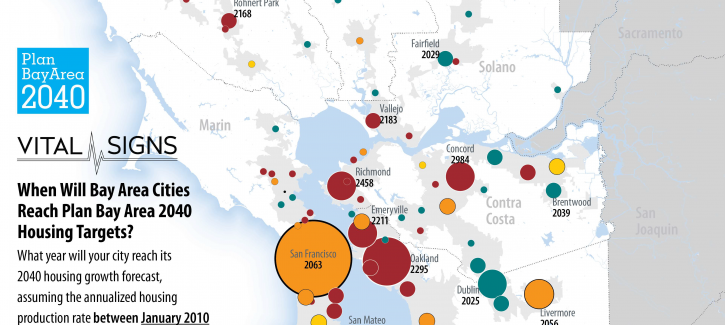SV@Home Deputy Director Pilar Lorenzana underscored the need to balance housing production with job creation in order to alleviate the Bay Area’s housing crisis and traffic congestion as part of an interview with San Jose Mercury News reporter Erin Baldassari.
See the original story at the San Jose Mercury News.
It may take centuries to reach housing goals in Bay Area
By Erin Baldassari
At its current level of housing construction, it would take the East Bay city of Concord until 2984 — almost the next millennium — to reach its 2040 housing goals, according to a new map from the Metropolitan Transportation Commission (MTC).
Oakland residents would have to wait until 2295 before enough housing is built for its projected 2040 population. San Jose and San Francisco residents have it better off; residents’ grandchildren would see an adequate supply of housing for its 2040 population in 2066 and 2063, respectively.
The map, released last month, highlights the continued challenges of building housing in the Bay Area. Comparing Department of Finance housing production data from January 2010 to December 2017 with the state-mandated housing goals outline in MTC’s Plan Bay Area 2040 forecast, it shows the year in which each city or town would meet its housing goal for 2040 if it continues at the current pace of construction.
“It’s a sobering reminder of how far we have to go to get the Bay Area’s red-hot economy and its anemic residential sector into better balance,” Steve Heminger, the MTC’s executive director, said in a report to the commission.
Perhaps not surprisingly for most Bay Area residents, the majority of cities — and all Bay Area counties — are lagging behind their 2040 housing goals while at the same time continuing to add jobs. That imbalance between the number of jobs and the housing that’s available does two things, said Matt Regan, the senior vice president of public policy for the Bay Area Council: Force working and middle-income people to move further away in search of affordable housing and make commutes a lot longer and highways more congested.
“Development follows the path of least resistance,” Regan said. And, the evidence is in the map.
The cities that are actually on track to add housing are the ones furthest from the job centers in the Bay Area and are places with fewer public transit options, which forces more people to drive: Dublin, Pleasanton and San Ramon in the Tri-Valley; Pittsburg and Brentwood in east Contra Costa County; Fairfield in Solano County; and Gilroy and Morgan Hill in Santa Clara County.
“That means we are building homes on virgin land and open space … far away from the job centers in the urban core, where housing production is anemic,” Regan said. “Almond orchards don’t file CEQA lawsuits or show up at council to fight new housing, but angry neighbors do.”
That might seem counter-intuitive to some residents, especially in the Bay Area’s three largest cities, where cranes dot the skyline, said Pilar Lorenzana, deputy director for Silicon Valley at Home, an affordable housing advocacy nonprofit. In other cases, such as Marin or San Mateo, which have historically resisted development, the stereotypes are confirmed, she said.
“We are churning out a massive number of jobs,” she said. “So, even though community members are up in arms against development, because they feel like too much development is happening, it’s actually not enough. Or at least, it’s not enough for the number of jobs we are creating.”
The map doesn’t distinguish between affordable or market-rate housing, said David Vautin, a principal planner at MTC, who helped create it. But, other data from the MTC shows the gap between what is being built and what is needed when it comes to affordable housing is even wider, he said.
Still, Lorenzana is hopeful this trend can be reversed, or at the very least, slowed. Housing bills approved by the legislature last year removed some of the control cities have over approving new housing projects if they aren’t meeting their targets. Cupertino, a city historically resistant to development, allowed a 2,400-unit housing development to move toward approval, which is expected to be finalized in September, after years of delays because it was lagging far behind its 2040 housing goals.
“We have more tools now to hold cities accountable and more tools to make housing production happen in a much quicker time-frame,” she said.
And, Vautin said, there has been an acceleration of growth in recent years, even if the pace of housing construction was particularly sluggish following the Great Recession. The MTC, which primarily focuses on transportation planning, is paying close attention to housing data because it has such a big impact on traffic congestion, he said.
“It’s a primary driver of all our transportation problems,” he said.
Plan Bay Area is a roadmap to long-range planning in the Bay Area. It sets goals for reducing greenhouse gas emissions, providing adequate housing, preserving open space and improving health, along with creating a plan for needed transportation infrastructure, to accommodate projected population growth.
